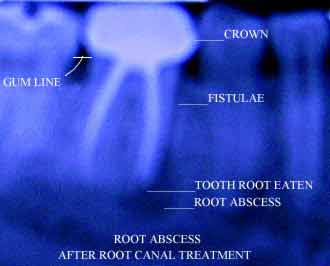 Your dentist will probe your teeth with a dental instrument. If you have an abscessed tooth, you will feel pain when the tooth is tapped by your dentist's probe. Your dentist will also ask you if your pain increases when you bite down or when you close your mouth tightly. In addition, your dentist may suspect an abscessed tooth because your gums may be swollen and red.
Your dentist will probe your teeth with a dental instrument. If you have an abscessed tooth, you will feel pain when the tooth is tapped by your dentist's probe. Your dentist will also ask you if your pain increases when you bite down or when you close your mouth tightly. In addition, your dentist may suspect an abscessed tooth because your gums may be swollen and red. |
Your dentist may also take X-rays to look for erosion of the bone around the abscess.
The pain is continuous and may be described as gnawing, sharp, shooting, or throbbing. Putting pressure or warmth on the tooth may induce extreme pain. There may be a swelling present at either the base of the tooth, the gum, and/or the cheek, which can be alleviated by applying ice packs.
An acute abscess may be painless but still have a swelling present on the gum. It is important to get anything that presents like this checked by a dental professional as it may become chronic later.
In some cases, a tooth abscess may perforate bone and start draining into the surrounding tissues creating local facial swelling. In some cases, the lymph glands in the neck will become swollen and tender in response to the infection. It may even feel like a migraine as the pain can transfer from the infected area. The pain does not normally transfer across the face, only upwards or downwards as the nerves that serve each side of the face are separate.
Severe aching and discomfort on the side of the face where the tooth is infected is also fairly common, with the tooth itself becoming unbearable to touch.
No comments:
Post a Comment